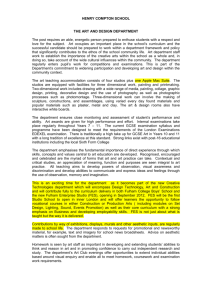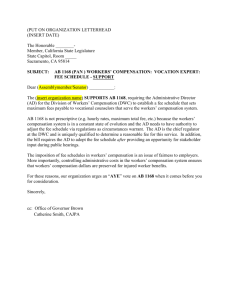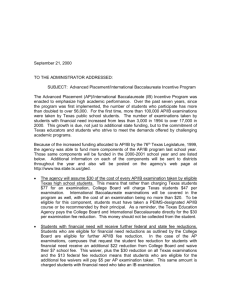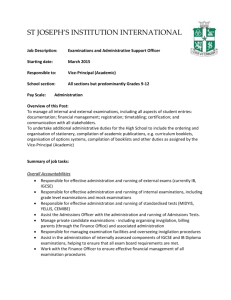Compensation and Pension Examinations: Determinant the Right
advertisement
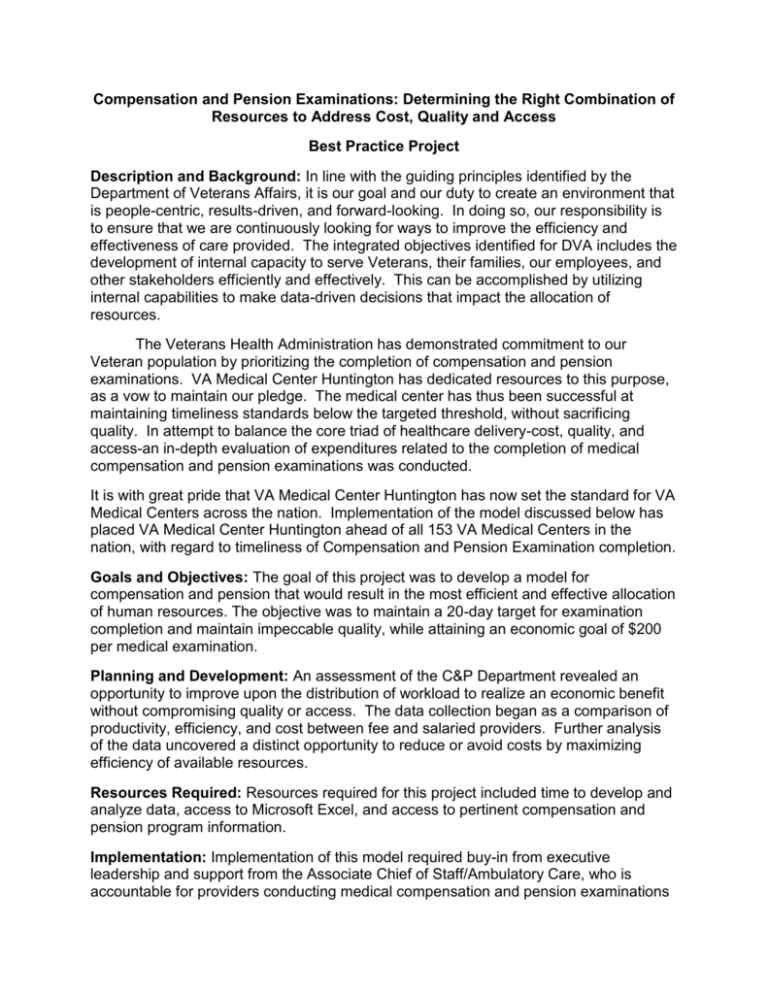
Compensation and Pension Examinations: Determining the Right Combination of Resources to Address Cost, Quality and Access Best Practice Project Description and Background: In line with the guiding principles identified by the Department of Veterans Affairs, it is our goal and our duty to create an environment that is people-centric, results-driven, and forward-looking. In doing so, our responsibility is to ensure that we are continuously looking for ways to improve the efficiency and effectiveness of care provided. The integrated objectives identified for DVA includes the development of internal capacity to serve Veterans, their families, our employees, and other stakeholders efficiently and effectively. This can be accomplished by utilizing internal capabilities to make data-driven decisions that impact the allocation of resources. The Veterans Health Administration has demonstrated commitment to our Veteran population by prioritizing the completion of compensation and pension examinations. VA Medical Center Huntington has dedicated resources to this purpose, as a vow to maintain our pledge. The medical center has thus been successful at maintaining timeliness standards below the targeted threshold, without sacrificing quality. In attempt to balance the core triad of healthcare delivery-cost, quality, and access-an in-depth evaluation of expenditures related to the completion of medical compensation and pension examinations was conducted. It is with great pride that VA Medical Center Huntington has now set the standard for VA Medical Centers across the nation. Implementation of the model discussed below has placed VA Medical Center Huntington ahead of all 153 VA Medical Centers in the nation, with regard to timeliness of Compensation and Pension Examination completion. Goals and Objectives: The goal of this project was to develop a model for compensation and pension that would result in the most efficient and effective allocation of human resources. The objective was to maintain a 20-day target for examination completion and maintain impeccable quality, while attaining an economic goal of $200 per medical examination. Planning and Development: An assessment of the C&P Department revealed an opportunity to improve upon the distribution of workload to realize an economic benefit without compromising quality or access. The data collection began as a comparison of productivity, efficiency, and cost between fee and salaried providers. Further analysis of the data uncovered a distinct opportunity to reduce or avoid costs by maximizing efficiency of available resources. Resources Required: Resources required for this project included time to develop and analyze data, access to Microsoft Excel, and access to pertinent compensation and pension program information. Implementation: Implementation of this model required buy-in from executive leadership and support from the Associate Chief of Staff/Ambulatory Care, who is accountable for providers conducting medical compensation and pension examinations and the support of the Business Office Chief, who oversees the individuals who schedule the examinations and collect data. Data Collected: Data regarding the total number of C&P examinations completed for FY10 and FYTD, date of examination request, date examination scheduled, date of signature and submission, as well as provider specific data, were obtained from Business Office personnel. Compensation for fee C&P providers was obtained from Fiscal Service for FY10 and FYTD. Data pertaining to salary, bonus pay, and benefits was obtained from Human Resources for salaried personnel. A pay survey was conducted to determine the average rate paid to providers for completion of medical compensation and pension examinations. Outcomes: Based on projections using data from FY10 and forecasting demand for FY11, it was estimated that $661,633 would be spent funding providers for medical compensation and pension examinations in FY11. Fixed costs, identified as those associated with salaried personnel, were identified. Using the total number of estimated examinations for FY11 and the target examination rate, a cumulative goal was established. Fixed costs were deducted, leaving the remainder to be divided among variable costs (cost of fee providers). A data table was then constructed to determine the most economically advantageous combination of resources to distribute examinations accordingly. Cost Savings: A potential cost avoidance of $100,000/yr is projected. Benefits and Recommendations: Utilizing this method of resource allocation maximized utility of available resources, reduced the amount of examinations conducted by fee providers, and a established a more judicious process for determining distribution of examinations among providers, both salaried and fee, alike. Additional best practice initiatives identified include: 1) Utilization of the ACOS/Ambulatory Care to maximize resource efficiency when faced with a high no-show rate. 2) Incentivize timely completion of examinations by fee providers by instituting an adjusted pay scale that reduces payment for examinations that are signed greater than three days following completion. 3) Establishment of clear productivity standards for salaried providers. 4) Development of a scheduling hierarchy: salaried providers, mid-level fee providers, fee physicians Application Potential in other Facilities: The forecasted budget for Veterans Health Affairs will require Executive Leadership to identify innovative ways to continue to provide the same level of care with restricted funding. Thus, it is imperative to ensure that all services within a medical center are scrutinized to ensure judicious resource utilization. Fee care, whether for compensation and pension examinations or for direct patient care and treatment, is the most difficult element in a medical center budget to predict and to control. In addition, it serves as the second highest expense for most facilities; therefore, every effort should be taken to contain fee costs when the opportunity presents. C&P is one area in which fee costs can be contained and controlled to an extent. Although circumstances are different at each facility, the method of evaluation presented in this project may be used to determine resource allocation in any setting. Point of Contact: Julia Spence Huntington, WV VA Medical Center (304)429-6741, ext 3217 Julia.spence@va.gov


